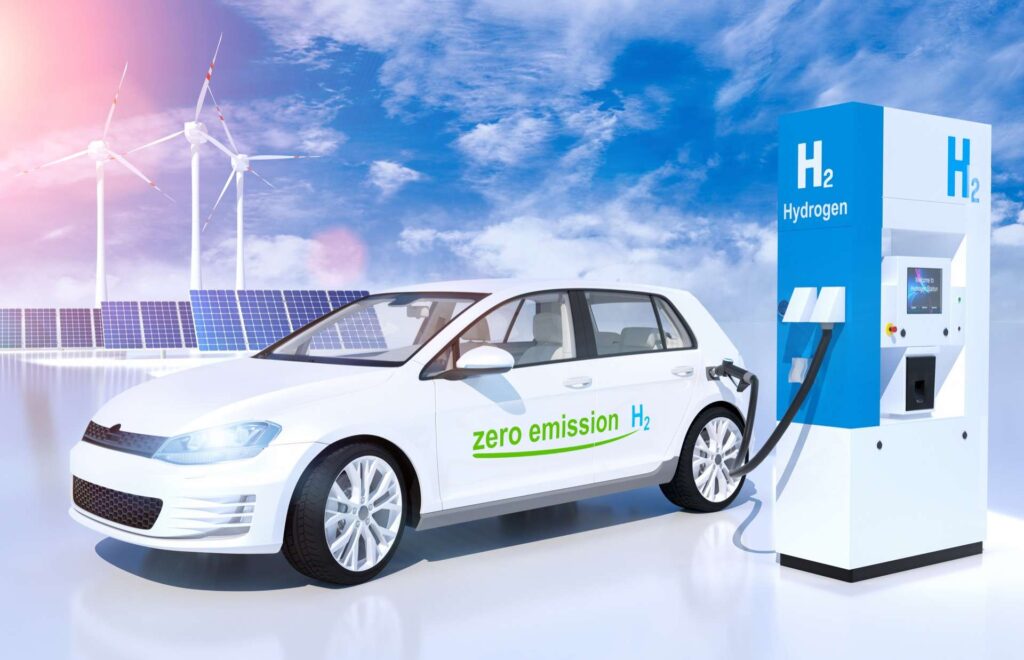How do hydrogen vehicles work?
Hydrogen vehicles, also known as fuel cell electric vehicles (FCEVs), operate using a technology that is fundamentally different from traditional cars. Instead of burning fuel, these vehicles use a fuel cell to convert hydrogen stored in a tank into electricity through an electrochemical reaction. This electricity then powers an electric motor that drives the wheels.
The process is straightforward: hydrogen, combined with oxygen from the air, generates electricity and produces water vapor as the only by-product. No CO2, no harsh particles—just water vapor escaping from the exhaust.
Advantages of hydrogen vehicles
Hydrogen cars offer several benefits, placing them in a strong position to become a key pillar of sustainable mobility.
Impressive range: One of the biggest advantages of hydrogen vehicles is their range. Unlike conventional electric cars, which often require several hours to recharge their batteries, hydrogen vehicles can be refueled in just a few minutes—similar to gasoline cars. Additionally, their range often surpasses that of battery-electric vehicles, easily reaching 500 to 700 kilometers on a single fill-up.
Zero emissions: The main environmental benefit of hydrogen cars is that they emit no greenhouse gases or particulate pollution while driving. Only water vapor is released, making them an ideal solution for reducing air pollution in urban areas and contributing to the fight against climate change.
An alternative to heavy batteries: Traditional electric vehicle batteries are heavy and require rare, expensive materials such as lithium and cobalt, which have significant environmental and ethical impacts during extraction. Hydrogen vehicles avoid this issue by using lighter fuel cells that are less reliant on these materials.
Challenges for hydrogen vehicles
Despite their many benefits, hydrogen vehicles face challenges that could hinder their widespread adoption.
High costs:The production costs of hydrogen cars remain high compared to electric or gasoline cars. This is due to the cost of manufacturing fuel cells and hydrogen tanks, as well as the relatively high price of hydrogen itself, especially if it is produced sustainably (green hydrogen).
Limited refueling infrastructure: One of the biggest challenges is the lack of hydrogen refueling infrastructure. While charging stations for electric vehicles are becoming more common, hydrogen refueling stations are still rare and expensive to set up. This limits the practicality and appeal of hydrogen vehicles for consumers.
Hydrogen production: Although hydrogen vehicles are clean, the way hydrogen is produced can be far less so. Currently, the majority of hydrogen is produced from natural gas, which generates CO2 emissions (gray hydrogen). Green hydrogen, produced from renewable energy, is still expensive and not yet widely developed at scale.
The future of hydrogen vehicles: promises and realities
The future of hydrogen vehicles is promising, but it will depend on several factors. For these vehicles to become a truly sustainable alternative, fuel cell costs must decrease, refueling infrastructure must expand, and hydrogen production must become cleaner and more accessible.
Several major car manufacturers, such as Toyota, Hyundai, and BMW, are already betting on hydrogen, investing heavily in the technology. Governments, especially in Europe and Asia, also see hydrogen as a critical tool for achieving their CO2 reduction targets. With the right incentives and strong political will, hydrogen cars could become a key part of tomorrow’s automotive landscape.
Conclusion: Hydrogen, a bet on the future
Hydrogen vehicles may not yet be the miracle solution, especially for heavy and light-duty vehicles alike, but they represent a promising pathway for sustainable mobility. Their ability to offer significant range, refuel quickly, and emit only water vapor makes them an appealing option. However, success will depend on overcoming challenges related to cost, infrastructure, and the development of clean hydrogen production.
In the end, the future of sustainable mobility may rest on a mix of technologies, with hydrogen vehicles playing a key role alongside battery-electric cars and other innovative solutions. The road to an emission-free future is still long, but hydrogen vehicles could help get us there faster.
The solution developed by HSL offers a high-density liquid hydrogen vector, optimally storable at fuel distribution stations to deliver gaseous hydrogen on demand with reduced risk. This system is highly competitive, as it seamlessly integrates into existing liquid fuel distribution networks. Thanks to its liquid form, it allows up to five times more hydrogen to be stored in the same volume compared to compressed hydrogen at 350 bar, thus providing an efficient and safe solution for energy transport and storage.


